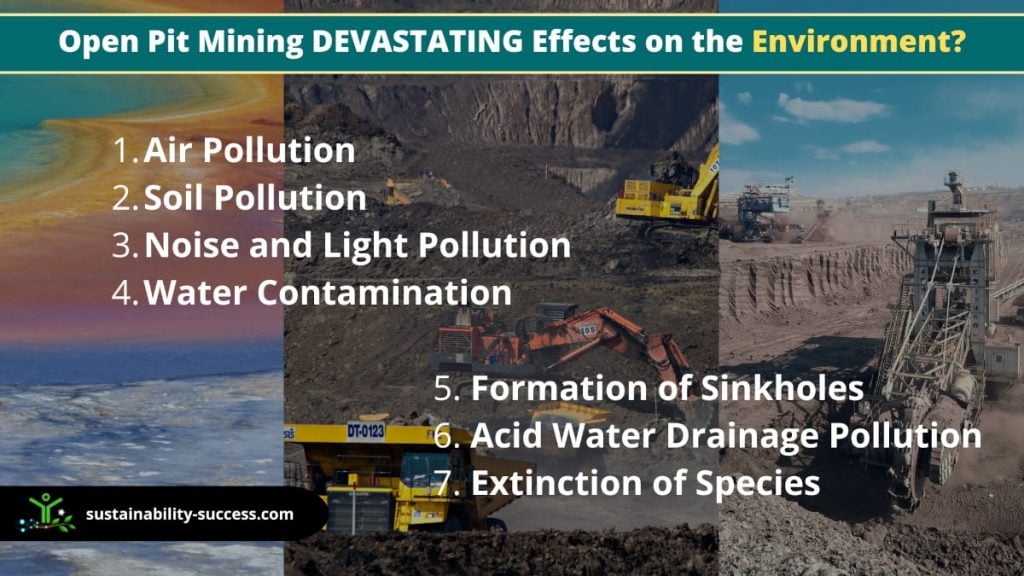Open pit mining is one of the top-leading mining approaches that cause devastating effects on the environment. Compared with underground mining, open pit mining releases 8-10 times more waste and debris into the environment.
This type of mining has a negative effect on the air, soil, water, and it even poses high health risks to individuals living near the mining region.
Key Takeaways
- Open pit mining significantly harms air, soil, water, and ecosystems.
- It causes air and water pollution, soil erosion, and species extinction.
- The process is resource-intensive, altering landscapes and affecting nearby communities.
In this article, we discuss in detail what open pit mining is and how it causes significant problems to the environment. What are the disadvantages of open pit mining? Read on!
What is Open Pit Mining?
Open pit mining, also known as open cast mining, is a surface mining technique where large pits are excavated to extract minerals, stones, or ores from the Earth’s shallow layers.
This method uses explosives to create holes, which are then expanded and deepened by heavy machinery to access and transport the valuable materials.
Typically used for extracting both metallic and non-metallic mineral ore deposits, this approach allows for efficient material extraction but transitions to more expensive underground mining when deposits are found at greater depths.
Why Is Open Pit Mining bad for The Environment?

Is open pit mining bad for the environment?
Open pit mining remains unsustainable in almost all areas. It consumes large amounts of water, destroys the biophysical environment permanently, disfigures landscapes, and releases toxic chemicals into the atmosphere.
And even long after the pits have been exhausted and the mining sites rehabilitated, these areas still remain highly prone to flooding and erosion. Hence, this mining approach is ranked among the top activities that hinder environmental sustainability.
When considering the open pit mining environmental impact and disadvantages, those are 7 devastating environmental problems that are caused by open pit mining!
Consider those open pit mining disadvantages:
1. Air Pollution
One of the top devastating effects caused by the open cast mining process is air pollution. Drilling and blasting the ground leads to the development of heavy dust clouds in the atmosphere.
Since the dust may even come from radioactive ores, it may contain heavy metals that are not only unsafe for vegetation and microorganisms but also dangerous for humans.
In fact, some dust clouds from open pit mines contain heavy metals that, when inhaled, lead to serious respiratory issues, such as black lung disease.
Besides, some explosives used to blast rocks release highly toxic fumes and gases, such as nitrogen dioxide. When these gases are released into the atmosphere, they pollute the air and lead to acid rain.
Furthermore, cases have been reported when mining equipment malfunctioned, causing the coal to ignite. Such mine fires emit harmful gases into the atmosphere that pollute the air. And as proven by research, emissions from mine sites are usually more harmful than those released by automobiles.
2. Soil Pollution
Coal and mineral ores are usually found under the ground’s surface. To access these, miners have to dig the ground, remove the topsoil and destroy any vegetation and rocks that may be found on the surface. Removing the topsoil and vegetation leaves the ground surface exposed, making it prone to soil erosion.
During mining, rocks that were buried deep into the ground are left exposed to the atmosphere. And when these rocks are broken or polished, they may emit radioactive substances and other harmful chemicals into the atmosphere.
These harmful substances affect the region’s soil, even leading to permanent damage to the land and surrounding environment.
3. Noise and Light Pollution
Open pit mines use very expensive machinery to excavate mineral ores. To make the most out of these machines, most of these operate 24/7.
The machines used for mining produce so much noise, causing untold noise pollution to the people and wildlife living near the mine sites.
In addition, since the mining process produces huge clouds of dust that inhibit a clear view, it leads to light pollution in the areas.
4. Water Contamination
In open pit mining, plenty of soil and rocks are removed to access the coal or mineral ores being extracted. The soil or rock layer is known as overburden. When the overburden is dumped into the disposal pits, it forms waste.
The waste products are usually produced by the excavated mineral ores, and even from the extraction and processing activities.
But have you ever thought about where all these waste products go after excavation? The fact is that most of these contaminants move to the nearby water supply, releasing toxic chemicals into it. Mineral ores with higher toxic components release more chemicals, contaminating the water bodies, and affecting the aqueous ecosystem negatively.
Also, as the overburden is removed and deposited in the disposal sites, some rocks get crushed in the process. These rocks emit radioactive chemicals which may flow into water bodies near the mining region.
Even worse, any residue water from the mining sites is usually directed to the nearby water resources, leading to their pollution.
5. Formation of Sinkholes
When the overlying strata are removed and displaced during open pit mining, it leads to the formation of cavities known as sinkholes.
These cavities can also be caused by shallow depth extraction, earthquakes, poor removal processes of waste products and geological disturbances.
Sinkhole subsidence makes the environment prone to damage. For example, some cavities release harmful chemicals into the environment, suffocating any nearby vegetation and species.
Also, sinkholes affect water flow and may even cause damage to surface structures, such as buildings.
6. Acid Water Drainage Pollution
Open cast mining exposes deep-seated rocks to the ground’s surface; rocks that contain toxic airborne substances. For example, when pyrite is exposed to the atmosphere, it releases sulfur into the air. When sulfur reacts with air and rainwater, it creates acid rain.
In turn, when the acid rain falls on the exposed rocks, it frees any heavy metals embedded in the rocks, sweeping these along into water bodies.
Such acid water drainage not only causes significant water pollution but also leads to the death of aquatic wildlife. Sometimes, on-site accidents also directly cause acid water drainage pollution.
Take, for instance, the accident that occurred at the Mount Polley Tailings Storage Facility. The dam, where heavy metals, chemicals, and solvents obtained from the intensive purification processes were collected, collapsed releasing 8,000,000 cubic meters of these tailings into three lakes.
The polluted water body became an even deeper and wider valley, while the surrounding areas were filled win metallic sludge. Even today, the regions have never been fully restored to their original conditions.
7. Extinction of Species
Most open pit mining sites are regions with dense biodiversity. And since the surface mining process leads to mass land degradation, it causes most species to go extinct.
The open pit mining process releases toxic chemicals and pollutants into the atmosphere, causing organisms present in the region to suffocate and die.
This is why surface mining is called into question when it comes to promoting sustainable development. We should find more sustainable ways to access natural resources, avoiding environmental degradation.
Conclusion
An interesting fact to note is that open pit mining is considered one of the safest mining approaches. Compared with other types of mining, surface mining has minimal chances of experiencing fires, releasing toxic gases that can kill miners, or the ground collapsing and burying miners underneath.
Even so, this does not mean that we should overlook the devastating effects that open pit mining has on the environment.
The surface mining approach leads to pollution of the air, soil, water and destruction of the natural habitat. Therefore, since attaining sustainable development is the ultimate goal, it is high time we put into place control measures to reduce the drastic impact of open pit mining on the environment and balance all the pillars of sustainability!

